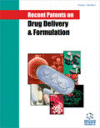- Home
- A-Z Publications
- Recent Patents on Drug Delivery & Formulation
- Previous Issues
- Volume 2, Issue 3, 2008
Recent Patents on Drug Delivery & Formulation - Volume 2, Issue 3, 2008
Volume 2, Issue 3, 2008
-
-
Recent U.S. Patents on Protein Drug Formulation: 2000-2007
More LessAuthors: Hong Zhao and Elizabeth M. ToppThis review summarizes U.S. patents on protein drug formulation issued during the period 2000-2007. The patents fall into four major areas: (i) protein stabilization in solution and solid formulations, (ii) polymer-conjugated and chemically modified proteins, (iii) controlled release protein formulations, and (iv) protein formulation for novel routes of administration. Patents issued in each of the four areas are described and Read More
-
-
-
Innovations in Coating Technology
More LessAuthors: Sharareh S. Behzadi, Stefan Toegel and Helmut ViernsteinDespite representing one of the oldest pharmaceutical techniques, coating of dosage forms is still frequently used in pharmaceutical manufacturing. The aims of coating range from simply masking the taste or odour of drugs to the sophisticated controlling of site and rate of drug release. The high expectations for different coating technologies have required great efforts regarding the development of reproducible Read More
-
-
-
Intra-Articular Drug Delivery: A Fast Growing Approach
More LessJoint diseases are a leading cause of pain and disability in the adult population. Attempts have been made over the years to alleviate the pain accompanying these diseases and to decrease the incidence of joint degeneration. The utilization of the intra-articular route for the delivery of drugs and other macromolecules has recently evolved making use of the avascularity of the cartilage tissue to allow regional administra Read More
-
-
-
Microemulsions: A Novel Approach to Enhanced Drug Delivery
More LessAuthors: Sushama Talegaonkar, Adnan Azeem, Farhan J. Ahmad, Roop K. Khar, Shadab A. Pathan and Zeenat I. KhanMicroemulsions are isotropic, thermodynamically stable transparent (or translucent) systems of oil, water and surfactant, frequently in combination with a cosurfactant with a droplet size usually in the range of 20-200 nm. They can be classified as oil-in-water (o/w), water-in-oil (w/o) or bicontinuous systems depending on their structure and are characterized by ultra low interfacial tension between oil and water phases. Read More
-
-
-
Orally Disintegrating Systems: Innovations in Formulation and Technology
More LessAuthors: Honey Goel, Parshuram Rai, Vikas Rana and Ashok K. TiwaryOrally disintegrating systems have carved a niche amongst the oral drug delivery systems due to the highest component of compliance they enjoy in patients especially the geriatrics and pediatrics. In addition, patients suffering from dysphagia, motion sickness, repeated emesis and mental disorders prefer these medications because they cannot swallow large quantity of water. Further, drugs exhibiting satisfactory absorptio Read More
-
-
-
Emerging Role of Microemulsions in Cosmetics
More LessMicroemulsions represent a promising carrier system for cosmetic active ingredients due to their numerous advantages over the existing conventional formulations. They are capable of solubilizing both hydrophilic and lipophilic ingredients with relatively higher encapsulation. There is growing recognition of their potential benefits in the field of cosmetic science in addition to the drug delivery. They are now being widely Read More
-
Most Read This Month
Article
content/journals/ddf
Journal
10
5
false
en


